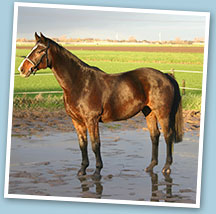
Keeping your horse healthy in rainy weather
For horses, damp, wet weather is often synonymous with two conditions: mud fever and rain scald. Here, equine vet Karen Coumbe MRCVS explains the causes of these common conditions and how to deal with them.
At this time of year, bad weather can start to cause havoc with our horses’ skin. Damp air, dark nights, little sunshine, continual waterlogging and inappropriate rugging for changing weather conditions all mean it’s hard to get anything to dry, putting your horse at risk of mud fever and rain scald. Although these two common conditions can occur in the summer months, the elements mean they are most frequent during the winter.
Mud fever
Despite its name, mud fever, or pastern dermatitis, is actually a range of skin reactions to bacterial infection, mite infestation and other skin irritants, which affect a horse’s lower limbs.
A horse’s skin is amazingly delicate. Rubbing from boots or tack, or even being worked in a sand school, can cause tiny cuts that let in bacteria. Prolonged wetting, from damp and muddy conditions or excessive sweating under rugs, softens the skin, making it more susceptible to infection. Mud fever is commonly caused when the skin on the lower limbs is compromised in such a way and becomes infected by the soil-dwelling bacteria Dermatophilus congolensis, which are bacteria that do not invade dry, healthy skin.
The signs
Mud fever causes a horse’s skin to become inflamed and sore. Pink-skinned limbs with white hair are the most delicate, but horses with dark skin can suffer from the condition, too. The skin becomes sore, crusty and scabby, hair falls off and the legs can swell – in severe cases mud fever can cause lameness. Although the long feathers around a horse’s fetlocks are protective, they can get completely waterlogged or infested with mites, which is one of the most common reasons for mud fever in heavy horses.
Treatment
Management depends on the cause and the case – but first try to get your horse out of the wet conditions. Wash the scabs with warm water and a mild antiseptic, allowing sufficient time for it to soak in. Then try to remove crusting and loose hair as best you can and gently dry the skin after washing, applying a soothing emollient cream – ask your vet which is best. In severe cases, bandaging helps protect the legs, stops them swelling, keeps them clean and dry and encourages healing.
Rain scald
Rain scald, also known as rain rot, is similar to mud fever but affects a horse’s whole torso. It is particularly common along a horse’s shoulders and back, where the body gets wet and waterlogged – when it is constantly damp, the skin becomes infected by the same bacteria that cause mud fever. The worst cases are seen in horses that are left out all winter, unrugged and often in regrettably poor condition, though it can also develop when horses sweat under rugs and blankets.
Rain scald can affect any colour of horse, but it is more obvious on the grey patches of coloured horses. If your horse has a thick, dark coat, you may not actually notice it unless you run your hands along the hair. If your horse is rugged and lives outside, he could get a line of rain scald along his back without you noticing, so run your hand along his back and under rugs regularly to check.
Helping your horse
There is no easy treatment for rain scald other than getting your horse away from the rain and drying him out. It is better not to clip his coat when it’s affected, but if you must, do it very carefully. Wash the scabs with a mild antiseptic recommended by your vet, and if your horse has rain scald in the saddle area, don’t ride him until it has resolved. Antibiotics aren’t the answer on their own – you need to remove your horse from exposure to wetting, and most cases get better on their own if the skin is kept dry.
Many skin conditions, like mud fever and rain scald, can be infectious. So make doubly sure that you keep grooming kits, rugs and numnahs separate and clean for each horse.



